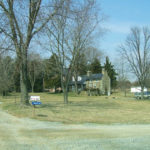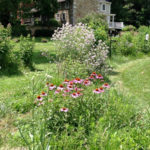Volume 22 Issue 1, Spring 2017
by Anne Owen, Audubon at Home Ambassador




Photos by Janet Locklear
When long-time Loudoun Wildlife Conservancy member Janet Locklear purchased her property a little over 10 years ago, she had an area of woodland, including some beautiful, mature, native trees, but also a large expanse of lawn, where in her words “there was no activity.”
Janet had a passion for birds and had spent many years as the Loudoun Wildlife Conservancy Bluebird Coordinator, but a talk by Doug Tallamy, author of Bringing Nature Home, kick-started her appreciation for the vital role that we can all play in providing healthy habitat for wildlife in our own backyards, so she signed up for Audubon at Home.
Like many of us, she started out in a modest way, attending a Native Plant Sale and going home with Milkweed, Joe-Pye Weed, Asters, and Goldenrod, all of which are key perennials for supporting pollinators. At the same time, she selected an area of her yard to simply let grow wild. While she has continued to add new native plants, those original selections have become established and now self-seed to populate new areas. She is even happy to let Milkweeds grow amongst her vegetable plot.
The new habitat has indeed attracted a variety of new critters, and Janet’s own interests have broadened. A great benefit to developing habitat that is beneficial for one group of species, such as butterflies, is also beneficial to others, such as native bees, and in turn to the birds that need caterpillars and grubs to raise their chicks. Last year Janet raised and released over 150 Monarchs, all fed and raised on Milkweed from her property. Now, she is increasingly interested in the native bees that are also coming to the pollinator plants. She has seen bumble bees, carpenter bees, digger wasps, and clearwing moths to name a few. She has a healthy population of birds, including Red-bellied and Downy Woodpeckers, Northern Cardinals, Chipping Sparrows, White-breasted Nuthatches, Eastern Bluebirds, Northern Mockingbirds, Gray Catbirds, Eastern Phoebes, and Chimney Swifts.
Janet’s advice is to try to not do too much and become overwhelmed — pick your battles! She plans to continue to reduce the amount of lawn on the property and wants to do more with sedges and native grasses. At the same time, she is adding shrubs to provide more habitat variety and is also moving some oak seedlings in the hope of encouraging new trees. It’s all a learning process.
Janet says that the biggest challenge is to find as much time as she would like to spend on her wildlife habitat, but the first thing that she likes to do when she gets home from her commute is to grab her binoculars or camera and head out to the wild area. Where it was previously quiet, there is now continuous activity and that is a great source of pleasure and relaxation.
If you would like to find out more about providing habitat for wildlife on your own property and the Audubon at Home program, please contact Ann Garvey at agarvey@loudounwildlife.org for more information.





